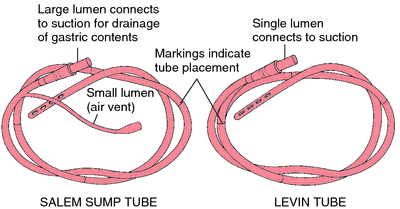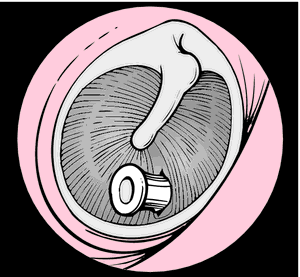tube
[to̳b] a hollow cylindrical organ or instrument. adj., adj tu´bal.
auditory tube eustachian tube.
Blakemore-Sengstaken tube Sengstaken-Blakemore tube.
chest tube see chest tube.
Dobhoff tube a small-lumen feeding tube that can be advanced into the duodenum.
drainage tube a tube used in surgery to facilitate escape of fluids.
Drieling tube a double-lumen tube having a metal weight at one end to carry it past the stomach into the duodenum. At the other end are two tails, one used to collect gastric specimens and the other to collect specimens from the duodenum. The tube is used in the secretin test for pancreatic exocrine function.
Durham's tube a jointed tracheostomy tube.
endobronchial tube a single- or double-lumen tube inserted into the bronchus of one lung and sealed with an inflatable cuff, permitting ventilation of the intubated lung and complete deflation of the other lung; used in anesthesia and thoracic surgery.
endotracheal tube see endotracheal tube.
esophageal tube stomach tube.
eustachian tube see eustachian tube.
Ewald tube a large lumen tube used in gastric lavage.
fallopian tube see fallopian tube.
feeding tube one for introducing high-caloric fluids into the stomach; see also tube feeding.
tube feeding a means of providing
nutrition via a feeding
tube inserted into the gastrointestinal tract; it may be done to maintain nutritional status over a period of time or as a treatment for malnutrition. It can be used as the only source of nutrition or as a supplement to oral feeding or
parenteral nutrition.
Patients who may require tube feeding include those unable to take in an adequate supply of nutrients by mouth because of the side effects of chemotherapy or radiation therapy, those with depression or some other psychiatric disorder, and those suffering from severe hypermetabolic states such as burns or sepsis, or malabsorption syndromes. Other conditions that may require tube feeding include surgery or trauma to the oropharynx, esophageal fistula, and impaired swallowing such as that which occurs following stroke or that related to neuromuscular paralysis.
There are commercially prepared formulas for tube feeding. Some contain all six necessary nutrients (carbohydrates, fats, proteins, vitamins, minerals, and trace elements) and need no supplement as long as they are given in sufficient volume to meet nutritional and caloric needs. Other types of tube feeding formulas are incomplete and therefore will require some supplementation. Choice of formula is based on the patient's particular needs, presence of organ failure or metabolic aberration, lactose tolerance, gastrointestinal function, and how and where the feeding is to be given, that is, via nasogastric, gastrostomy, or enterostomy tube.
Patient Care. In addition to frequent and periodic checking for tube placement and monitoring of gastric residuals to prevent aspiration, other maintenance activities include monitoring effectiveness of the feeding and assessing the patient's tolerance to the tube and the feeding. Special mouth care is essential to maintain a healthy oral mucosa. A summary of the complications related to tube feeding, their causes and contributing factors, and interventions to treat or prevent each complication is presented in the accompanying table.
fermentation tube a U-shaped tube with one end closed, for determining gas production by bacteria.
Levin tube a gastroduodenal catheter of sufficiently small caliber to permit transnasal passage; see illustration.

Two types of nasogastric tubes. From Ignatavicius et al., 1995.
Linton tube a triple-lumen tube with a single balloon used to control hemorrhage from esophageal varices. Once it is positioned under fluoroscopic control and inflated, the balloon exerts pressure against the submucosal venous network at the cardioesophageal junction, thus restricting the flow of blood to the esophageal varices.
Miller-Abbott tube see miller-abbott tube.
Minnesota tube a tube with four lumens, used in treatment of esophageal varices; having a lumen for aspiration of esophageal secretions is its major difference from the sengstaken-blakemore tube.
nasogastric tube see nasogastric tube.
nasotracheal tube an endotracheal tube that passes through the nose.
neural tube the epithelial tube produced by folding of the neural plate in the early embryo.
orotracheal tube an endotracheal tube that passes through the mouth.
otopharyngeal tube eustachian tube.
Rehfuss tube a single-lumen oral tube used to obtain specimens of biliary secretions for diagnostic study; it is weighted on one end so that it can be passed through the mouth and positioned at the point where the bile duct empties into the duodenum. See also biliary drainage test.
Salem sump tube a double-lumen nasogastric tube used for suction and irrigation of the stomach. One lumen is attached to suction for the drainage of gastric contents and the second lumen is an air vent. See illustration.
Sengstaken-Blakemore tube see sengstaken-blakemore tube.
stomach tube see stomach tube.
T-tube one shaped like the letter T and inserted into the biliary tract to allow for drainage of bile; it is generally left in place for 10 days or more in order to develop a tract through which bile can drain after the tube is removed. A T-tube cholangiogram is usually performed prior to removal of the tube in order to determine that the common duct is patent and free of stones. If stones are found they can be removed through the tube tract by instruments inserted under x-ray guidance.
test tube a tube of thin glass, closed at one end; used in chemical tests and other laboratory procedures.
thoracostomy tube a tube inserted through an opening in the chest wall, for application of suction to the pleural cavity; used to drain fluid or blood or to reexpand the lung in pneumothorax. See also chest tube.
tracheal tube endotracheal tube.
tracheostomy tube a curved endotracheal tube that is inserted into the trachea through a tracheostomy; see discussion under tracheostomy.
tympanostomy tube ventilation tube.
uterine tube fallopian tube.
ventilation tube a tube inserted after
myringotomy in chronic cases of middle ear effusion, such as in secretory or mucoid otitis media; it provides ventilation and drainage for the middle ear during healing, and is eventually extruded. Called also tympanostomy tube.

Tympanostomy (ventilation) tube. Polyethylene tubes are inserted surgically into the eardrum to relieve middle ear pressure and promote drainage of chronic or recurrent middle ear infections. Tubes extrude spontaneously in 6 months to 1 year. From Jarvis, 1996.
Wangensteen tube a small nasogastric tube connected with a special suction apparatus to maintain gastric and duodenal decompression.
Whelan-Moss T-tube a t-tube whose crossbar tube is larger in diameter than the drainage tube.
x-ray tube a glass vacuum bulb containing two electrodes; electrons are obtained either from gas in the tube or from a heated cathode. When suitable potential is applied, electrons travel at high velocity from cathode to anode, where they are suddenly arrested, giving rise to x-rays.
Miller-Keane Encyclopedia and Dictionary of Medicine, Nursing, and Allied Health, Seventh Edition. © 2003 by Saunders, an imprint of Elsevier, Inc. All rights reserved.
Patient discussion about tube
Q. can you get pregnant with your tubes tied if your tubes are tied can you get pregnant
A. you can but the chances are slim to none,plus if you do you can sue the doctors, 99% no,
Q. I have missed 2 periods and had my tubes tied. What could be wrong? I went to the doctor and she didnt even do an exam. She said dont worry until I have missed for 6 months.
A. go to enather dr. you have to be shure.
Q. She had an infection in her fallopian tubes. She is recovering now, but can she get pregnant again? My sister had a very bad pregnancy where she had lost her first child. She had an infection in her fallopian tubes. As it was an ectopic pregnancy, she had an operation where they made a small incision in the fallopian tube and removed the embryo. She was depressed for quite a while as she was looking forward to enjoying her new baby. She is recovering now, but can she get pregnant again?
A. i think that was an ectopic pregnancy. of course she can get pregnant again, although the past history of tubal pregnancy increases the risk of developing another ectopic pregnancy in the future. but don't worry, all your sister need to is always consult her health and future-pregnancy condition with her ob-gyn specialist.
i believe that what happened to your sister was non-complicated ectopic pregnancy, because the doctor was just doing the minimal invasive surgery in her fallopian tube. it still has the risks of having another ectopic one in her future pregnancy, but with a complete medical check-up and work-up, i'm sure she will just be doing well.
i just wrote a brief note about ectopic pregnancy, in case you want to read that :
http://doctoradhi.com/blog/2009/01/ectopic-pregnancy/
More discussions about tubeThis content is provided by iMedix and is subject to iMedix Terms. The Questions and Answers are not endorsed or recommended and are made available by patients, not doctors.

